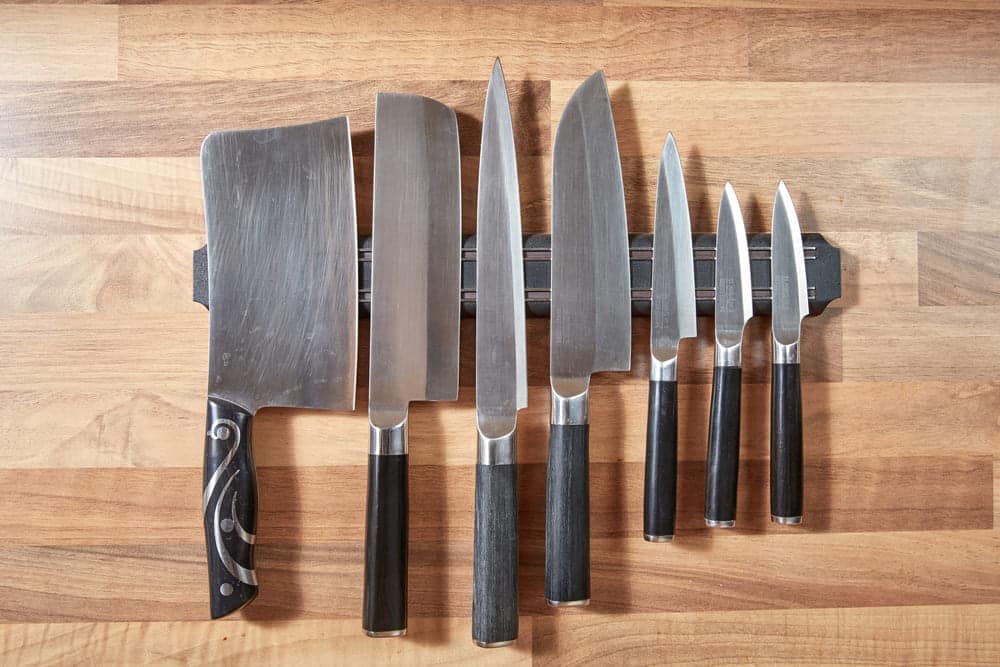
There are too many knives in the industry, and all of them are designed to serve different functions. To illustrate, all knives have different designs and blade shapes. However, there are some fundamental knives for every kitchen, such as cleaver vs. chef knife. So, if you are new to this, we are sharing information about these two knives!
Cleaver vs Chef Knife
Cleaver
The cleaver is known to be a large-size knife that has different shapes. However, the majority of cleavers are designed with a rectangular blade. Generally, cleavers are used in butcher shapes, but some people also use them regularly in kitchens. It is suitable for cutting huge pieces of soft bones. In addition, it can be used to cut through thick meat cuts (yes, it’s perfect for cutting steaks). Cleaver has a broadside that is suitable for crushing small vegetables, such as garlic.
In addition, the cleaver is perfect for scooping out the chopped food items. The most intriguing part is that cleaver has been around since the late 17th century but was known as clever. Cleaver tends to have a tough edge which has the capacity to manage the blows of cutting thick meat, bones, dense cartilage, and even the cutting board. This is because the blade is made with tough and soft steel. In particular, hard steel is avoided because it has chances of fracture.
When using, the users have to swing the cleaver like a hammer. You need to keep in mind that cleaver needs the right momentum for efficient cutting and chopping. For this reason, the cleaver’s edge is not very sharp. In some cases, the cleavers are designed with small holes on the top front corner for easier hanging. This is a great little hack since it reduces the chances of damages to the blade. These knives are suitable for cutting through soft and thin bones as well as sinew.
In the case of chicken, cleavers can help separate out the ribs and chop chicken through thin bones. There are special vegetable cleavers in the market which are suitable for cutting and preparing hard vegetables. However, it is not suitable for cutting the hard and thick bones. For the most part, cleavers are frequently used in China, and there are special Chinese cleavers as well. On the contrary, the Chinese variants are designed with thin cross-section and are for general cutting purposes.
Chef’s Knife
To begin with, the chef’s knife is known as cook’s knife. This cutting tool is widely used in preparing good, and it was designed for slicing large beef cuts. In addition, it is suitable for disjointing large beef cuts. For the most part, chef’s knife is known to be a utility knife. This knife pretty common among western chefs and cooks. Generally, this knife has an eight-inches blade length along with a 1.5-inches width. However, some models have 6-inches to 14-inches length as well.
Chef’s knife is designed with two types of blade shapes, such as German and French. The German-style has a constant and deep curve across the entire cutting edge. On the contrary, the French chef’s knife has a straighter edge till the end but has a curve-up on the tip. There is a Japanese version known as gyuto. The Japanese chef’s knife is likely to be sharper, smaller, and lighter, and the blade shape will be different. However, the Chinese version looks more like a cleaver.
For the most part, the chef’s knife is the multi-purpose knife that’s suitable for a variety of kitchen tasks, such as mincing, chopping, slicing, and disjointing larger meat cuts. As far as the blades are concerned, these knives are designed with stamped and forged blades. The forged chef’s knife uses the blank of steel that’s heated and beaten up for shaping the blade. Ad for the stamped blade, it is cut to shape from the cold-rolled steel and is treated with heat for higher temper and strength.
When it comes down to the blade, the chef’s knife can be made with stainless steel, carbon steel, and a combination of stainless steel and carbon steel. In some cases, you can also find the ceramic blade. Also, there are different edges found in chef’s knives, such as hollow ground, single grind, convex edge, and double grind.